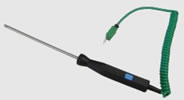Temperature measurement during operation and during adjustment and testing of electrical equipment
Temperature measurement is carried out when determining the state of insulation of equipment, heating and drying, when measuring the resistance of direct current of windings of machines and transformers, when performing thermal tests of electric motors and in some other cases.
Temperature is measured with mercury or alcohol thermometers. When using them, the head of the thermometer must fit tightly to the surface whose temperature is being measured, for which the head is wrapped in several layers of tinfoil and covered with heat-insulating material at the point of measurement (you can use cotton wool).
Temperature under magnetic field conditions is measured with alcohol thermometers to avoid measurement errors due to eddy current losses in mercury.
The placement of thermometers and the choice of their number are carried out in such a way as to cover the main places where temperature differences are possible. The average value of the readings of all thermometers is taken as the temperature.
 Most often, temperature is measured using thermocouples or thermocouples, which are collectively called thermal detectors.
Most often, temperature is measured using thermocouples or thermocouples, which are collectively called thermal detectors.
Commissioning practice often uses factory-made thermocouples and thermal resistances that are inserted into the equipment during manufacture to control heating during operation. Instrument readings correspond to overheating above the cold junction temperature, i.e. the air temperature in the room where the instrument and measuring switch are located.
 Factory thermocouples are manufactured as a single device kit. The factory thermocouples can be used only after their adjustment (checking, adjusting the adjustable resistances, checking the readings of the devices with the readings of a mercury or alcohol thermometer when heating together with thermocouples in an oil bath).
Factory thermocouples are manufactured as a single device kit. The factory thermocouples can be used only after their adjustment (checking, adjusting the adjustable resistances, checking the readings of the devices with the readings of a mercury or alcohol thermometer when heating together with thermocouples in an oil bath).
The temperature of the windings in some types of equipment (power transformers, generator rotors, etc.) during warm-up can be determined by measuring the DC resistance. In this way, the average temperature of the coil is determined, which in some cases is more preferable than measuring the temperature using thermometers or thermodetectors at its individual points. Temperature, ° C, in this case is determined by the formula

where Rgr is the winding resistance to direct current at the measurement temperature tgr; Rhol — DC resistance of the winding at initial temperature tcold; 235 is a constant factor for copper.
